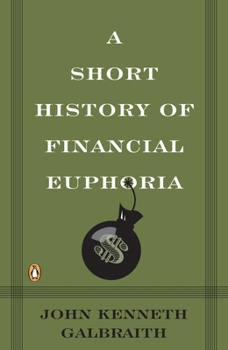A Short History of Financial Euphoria
Select Format
Select Condition 
Book Overview
The world-renowned economist offers "dourly irreverent analyses of financial debacle from the tulip craze of the seventeenth century to the recent plague of junk bonds." --The Atlantic. With incomparable wisdom, skill, and wit, world-renowned economist John Kenneth Galbraith traces the history of the major speculative episodes in our economy over the last three centuries. Exposing the ways in which normally sane people display...
Format:Paperback
Language:English
ISBN:0140238565
ISBN13:9780140238563
Release Date:July 1994
Publisher:Penguin Books
Length:128 Pages
Weight:0.26 lbs.
Dimensions:0.4" x 5.0" x 7.6"
Age Range:18 years and up
Grade Range:Postsecondary and higher
Customer Reviews
5 ratings
A must read for intelligent investors
Published by Thriftbooks.com User , 22 years ago
Galbraith paints a picture of the episodes of financial euphoria that allow one to see the seeds of the next bubble being planted. What Galbraith points out are the common themes of market bubbles. In the end, the same script is run as we hear that "this time is different" Although published in 1990, this reads like an epilogue to the tech/internet bubble of 1999-2000. The old saying goes that "what we learn from history is that we do not learn from history." Galbraith gives us the tools to learn from history. In an age of books like "Dow 36,000" and other mania induced work, this classic is a reality touchstone for all serious, sophisticated investors - individual and institutional alike. I would rate this book as a **********, but am limited to ***** (5 stars).
Bubble Story
Published by Thriftbooks.com User , 22 years ago
IN THIS SMALL but witty and well-crafted book, Galbraith chronicles the major speculative episodes, from the seventeenth-century tulipmania to the junk-bond follies of the eighties. The book was first published in 1990 and thus the recent dotcom-bubble burst is not covered. Nevertheless, the Harvard professor's book is still worth reading. A reason is that he claims to have identified common patterns in the history of financial euphoria. `In small ways the history of the great speculative boom and its aftermath does change. Much, much more remains the same', he predicts.The perennial features are these. Some seemingly new and desirable artifact or development captures the financial imagination of a large number of people (say, group 1). The arrival of tulips in Western Europe, gold in Louisiana, the advent of joint-stock companies (corporations), real estate in Florida, or the economic designs of Reagan are all examples. The price of the object of speculation goes up. The object when bought today is worth more tomorrow. This attracts new buyers and assures a further price increase. Those in group 1 are persuaded that the new price-enhancing circumstance is under control, and expect the market to stay up and go up, perhaps indefinitely. The individual or institution that discovered the novelty (in group 2) is thought to be ahead of the mob. Fewer in number, individuals of group 2 perceive the speculative mood of the moment, try to get the maximum reward from the increase as it continues, and plan to be out before the eventual crash. The affluence of group 2 is wrongly associated, by group 1, with a miraculous financial genius. When something triggers the ultimate reversal, group 2 decides now is time to get out. Group 1 finds its illusion abruptly destroyed. Both groups sell or try to sell. The market collapses.Galbraith observes that, in this process, `speculation buys up the intelligence of those involved'. The crowd converts the individual in group 1 from possessing reasonable good sense to stupidity. Those in group 2 also make errors of vanity by thinking they will beat the speculative game. It seems that `all people are most credulous when they are most happy'. Reputable public and financial opinion reinforces euphoria by condemning those who express doubt or dissent by warning of a crash. The celebrated Yale economist Irving Fisher, for instance, spoke out sharply against Roger Babson, who foresaw the crash of 1929. But the critic must wait until after the crash for any approval, Galbraith laments.Despite the fact that common features in speculative episodes recur, history counts little because a financial disaster is quickly forgotten by a new, self-confident generation. Something is perceived as a financial novelty merely because the financial memory is short: `financial operations do not lend themselves to innovation'. Insightfully, Galbraith notices that all financial innovation involves the creation of debt lev
critical thinking with a healthy dose of wit
Published by Thriftbooks.com User , 24 years ago
Reading about the history of speculation is a way to broaden one's critical views of investing. Galbraith presents the material in an entertaining way and doesn't oversell the important points he makes about mass psychology and market reform. His self-deprecatory moments are very engaging indeed. I would go so far as to suggest that this book should be required reading for any investor.
An Excellent Little Book
Published by Thriftbooks.com User , 24 years ago
A short, concise and powerful little book. What you would expect from Galbraith. On the short list of people who can write about finance and keep it entertaining.
This is as brilliant as what you would expect from Galbraith
Published by Thriftbooks.com User , 27 years ago
This book is funny, incisive, and important. It is as good as his others, although the scope is much narrower. Even those who don't agree with Mr. Galbraith's somewhat liberal views will have to admit that he is a great writer and a great thinker.





